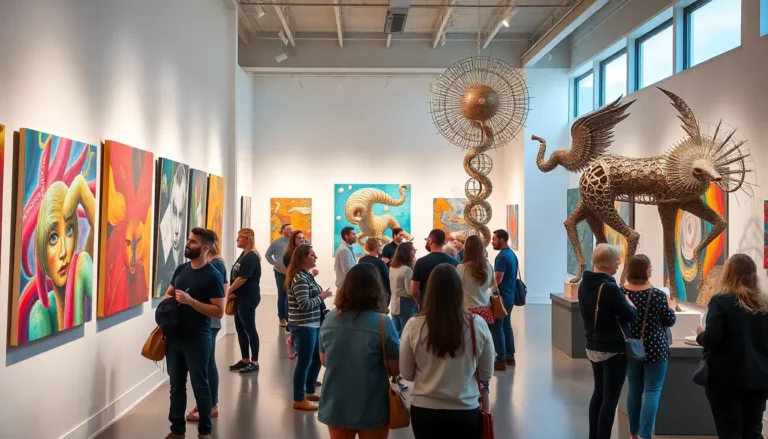Table of Contents
ToggleIn a world where art often reflects the complexities of life, female sculpture stands out like a beacon of strength and beauty. From ancient goddesses to modern masterpieces, these works capture the essence of femininity in all its forms. It’s not just about curves and contours; it’s about stories, emotions, and the sheer power of womanhood frozen in time.
Imagine walking through a gallery filled with stunning sculptures that not only please the eye but also spark conversations. Each piece tells a tale, inviting viewers to explore the depths of creativity and expression. Whether it’s a delicate figure or a bold statement, female sculptures challenge societal norms and celebrate the diverse experiences of women. So, let’s dive into this captivating world and discover how these incredible artworks continue to inspire and empower.
Overview of Female Sculpture
Female sculpture encompasses a rich history reflecting the diverse experiences of women. Ancient civilizations, including the Greeks and Egyptians, often portrayed feminine figures associated with fertility, beauty, and divinity. These early representations laid the groundwork for exploring themes of femininity in art.
Various mediums utilize female sculpture, such as marble, bronze, and clay. Each medium brings unique qualities that enhance the portrayal of the female form. Artists manipulate these materials to evoke emotions, capture the essence of womanhood, and convey powerful narratives.
Modern female sculptures frequently challenge traditional representations. Contemporary artists incorporate abstract forms and mixed media to express individuality and cultural identity. These pieces not only celebrate women’s strength but also confront societal expectations.
Prominent female sculptors, like Louise Bourgeois and Barbara Hepworth, have made significant contributions to the art form. Bourgeois’s work often delves into themes of domesticity and trauma, while Hepworth’s pieces highlight the connection between nature and femininity. Their unique approaches demonstrate the evolving conversation surrounding women’s representation in art.
Female sculptures continue to spark discussions about gender, identity, and empowerment. Museums worldwide frequently curate exhibitions focused on women artists, showcasing their influence on the art landscape. By engaging with these artworks, audiences gain insight into the complexities of women’s lives and experiences, reinforcing the significance of female sculpture in the art world.
Historical Context
Female sculpture has evolved significantly, reflecting societal attitudes toward femininity and womanhood. Various historical periods showcase distinct representations.
Ancient Civilizations
In ancient civilizations, female figures played a vital role in art. The Greeks depicted goddesses like Aphrodite, showcasing ideals of beauty and desire. Egyptian sculptures often featured women as symbols of fertility, with fertility represented through statues like the Venus of Willendorf dating back to 25,000 BCE. Both cultures used materials like stone and clay to immortalize these ideals, highlighting women’s importance in religion and society. These early works laid the foundation for understanding feminine representations, emphasizing attributes such as grace and power.
Renaissance and Baroque Periods
The Renaissance marked a resurgence of interest in the female form, reflecting humanism’s influence. Artists like Michelangelo portrayed women with exquisite detail, capturing both strength and vulnerability. During the Baroque period, sculptures showcased dramatic emotion and movement. Gian Lorenzo Bernini’s pieces revealed the psychological depth of female figures. Techniques such as chiaroscuro added a dynamic quality to marble, enhancing their lifelike presence. These centuries transformed female sculpture into a profound exploration of identity, allowing artists to express complex narratives through the female experience.
Prominent Female Sculptors
Female sculptors have made significant impacts in the art world, shaping perceptions of femininity and identity through diverse styles and mediums.
19th Century Artists
In the 19th century, female sculptors began to gain recognition, breaking societal barriers. Harriet Hosmer emerged as an influential figure, known for her neoclassical works that featured strong female subjects. Edmonia Lewis, another notable artist, gained acclaim with her intricate sculptures that combined African and Native American themes. These 19th-century artists laid the groundwork for future generations, challenging the male-dominated art world with their exceptional talent.
Contemporary Sculptors
Contemporary sculptors continue to redefine female representation and explore diverse themes. Louise Bourgeois addressed complex emotional landscapes, often reflecting domesticity and trauma in her work. Artists like Rachel Whiteread use materials like resin and plaster to create thought-provoking installations, pushing boundaries of traditional sculpture. Others, such as Chakaia Booker, blend recycled materials to convey messages about identity and the environment. These contemporary sculptors demonstrate the ongoing evolution of female sculpture, enriching the dialogue surrounding gender and art.
Themes and Motifs in Female Sculpture
Female sculpture often embodies complex themes that resonate with various aspects of femininity. These motifs explore identity, body representation, and emotional depth, serving as a medium for artists to convey their thoughts and perspectives.
Feminine Identity
Feminine identity plays a central role in many sculptures, capturing the essence of womanhood across different cultures. Artists utilize various techniques to depict women’s roles, struggles, and triumphs. Through symbolism, their works address societal expectations and personal experiences. Some sculptures convey empowerment, while others highlight vulnerability. These representations encourage dialogue about the multifaceted nature of being a woman, reflecting both strength and fragility in equal measure.
Body Representation
Body representation stands as a significant theme in female sculptures, showcasing the diversity of female forms. Sculptors focus on different body types to challenge conventional beauty standards. Some emphasize curves and grace to celebrate femininity, while others utilize abstraction to question established norms. Artists often employ materials like marble and bronze to enhance the physical properties of their subjects. Through this exploration, they underscore the importance of body positivity and inclusivity, inviting viewers to appreciate the uniqueness of each representation.
The Impact of Female Sculpture on Modern Art
Female sculpture significantly influences modern art by highlighting the evolution of female representation. Contemporary artists frequently draw inspiration from historical depictions of women, adapting traditional themes to reflect current societal issues. Many sculptors emphasize the need for inclusivity, showcasing diverse body types and experiences.
Art movements like feminism reshape the narrative surrounding female figures in sculpture. By addressing topics like gender equality and identity, these movements pave the way for new artistic expressions. Artists such as Louise Bourgeois and Yayoi Kusama use their platforms to explore personal and collective histories, challenging viewers to reconsider their perceptions of femininity.
In addition, many modern sculptures utilize innovative materials and techniques. Artists now incorporate mixed media and abstract forms to express complex themes related to womanhood. This departure from classical styles allows for a broader interpretation of what female sculpture represents.
Moreover, public installations and monumental sculptures challenge traditional spaces for art. These large-scale works invite audiences to engage with themes of femininity in their daily environments, bridging the gap between art and experience. Artists like Judy Chicago utilize community participation, creating a dialogue around female identity and history.
Significantly, exhibitions in leading museums highlight the contributions of female sculptors. These showcases emphasize the evolution of female artistry, celebrating both historical and contemporary works. The increased visibility of women artists enriches the dialogue surrounding female representation, fostering a deeper appreciation for their unique perspectives.
Overall, female sculpture continues to redefine its impact on modern art, acting as a powerful medium for expression and conversation. As art evolves, the voices of female sculptors become increasingly prominent, underscoring their role in shaping contemporary artistic landscapes.
Female sculpture stands as a testament to the evolving narrative of womanhood. Through various artistic movements and mediums, these works resonate with the complexities of identity and experience. They challenge conventions and invite deeper reflection on femininity in both historical and contemporary contexts.
The impact of female sculptors is undeniable. Their contributions not only enrich the art world but also foster a dialogue about gender representation. As audiences engage with these pieces, they find a mirror reflecting their own stories and struggles. Ultimately, female sculpture continues to inspire and empower, shaping a more inclusive future in the arts.







